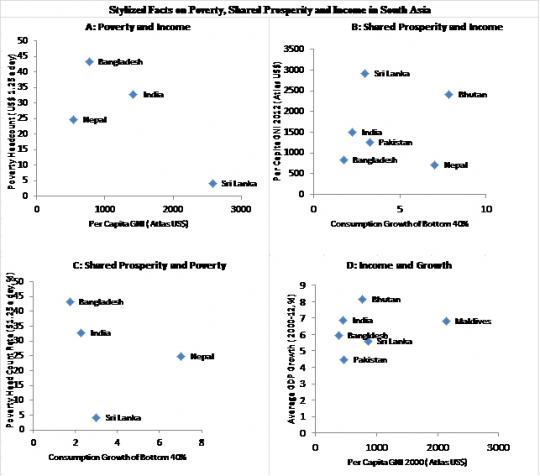Poverty has been a concern in societies even before the beginning of recorded history. In the past three decades extreme poverty in the world has decreased significantly. More than half of population in the developing world lived on less than $1.25 a day in 1981. This has dropped to 21% in 2010. More impressively, notwithstanding a 59% increase in population in developing countries, there were 1.2 people living on less than $1.25 a day in 2010, compared with 1.9 billion decades ago. However, the challenge of poverty reduction ahead remains daunting with 1.2 billion still living in extreme poverty. Freeing the world from poverty is perhaps the most important economic goal for the world today. More than a hundred countries are still not able to move away from high poverty traps.
Extreme poverty has declined in every developing region in the last three decades. Sub‐Saharan Africa (SSA) and Latin America and the Caribbean (LAC) turned a corner as they entered the new millennium. Extreme poverty rate fell 10 percentage points in SSA between 1999 and 2010 after increasing steadily from 51% in 1981 to 58% in 1999. It is now at 48%—a decline of 17% in just a decade. Extreme poverty was cut in half between 1999 and 2010 in LAC after remaining stable at approximately 12% for the last two decades of the 20th century. At 6% currently, extreme poverty is on the verge of being eradicated in LAC. The largest reduction was in the East Asia and Pacific region (which includes China, Indonesia, Viet Nam, the Philippines stretches westerly to Myanmar) where the extreme poverty rate dropped more than 80%.
Critical to global poverty reduction is South Asia, the second most populous region in the world, with 1.7 billion people in 2013 (24% of the world’s population). Poverty rates in South Asia fell from 44.3% in 2002 to 31% in 2010.The poverty headcount fell by 130 million people, from 636 million poor in 2002 to 506 million in 2010. Still 42% of the world’s poor live in South Asia. Why is South Asia so overwhelmingly poor? Some interesting data on poverty, shared prosperity and income is presented in the charts at the end. Note the following:
- Poverty is inversely related with the level of per capita income (chart A). While this reaffirms a time-tested long run economic regularity, there are aberrations as well. In the case of South Asia, Nepal has lower per capita GNI compared with both Bangladesh and India. Yet Nepal’s poverty incidence is lower than Bangladesh and India. The level of income is important but not the only determinant of poverty.
- The relationship between shared prosperity—as measured by the consumption growth rate of the bottom 40%--and per capita income is positive but not as strong as the relationship between poverty incidence and per capita income (chart B). Redistributive policies are easier to pursue at higher levels of income. However, Sri Lanka and Nepal present interesting contrasts. While Sri Lanka’s GNI per capita is over four times relative to that of Nepal, the income growth rate of the bottom 40% in Nepal was 2.3 times the income growth rate of their counterparts in Sri Lanka. Again, income is important but not everything.
- One would think wider sharing of prosperity will correlate with lower poverty incidence. This is true for Bangladesh with lowest growth rate of consumption in the bottom 40% and highest poverty incidence in the region (chart C). Consumption growth of the bottom 40% was the highest in Nepal, yet Sri Lanka has the lowest poverty incidence. The influence of the level of income on poverty reduction appears to overwhelm distributional factors.
- There is no evidence of regional convergence in the level of per capita income (chart D). The tendency of catch-up convergence whereby the initially worse off (Bangladesh) grow faster than the better off (Bhutan) is not evident yet. This is not surprising because trade—the most important thread that ties countries together—is missing in South Asia. Intra-regional trade is among the lowest in the world in South Asia.
Freeing the South Asian region from poverty and boosting shared prosperity will require addressing the barriers to intra-regional trade in goods, services, labor, and capital. This should not be difficult to comprehend. The key to sustained poverty reduction is economic growth. While growth may not benefit everyone, there is little reason to fear that growth associated with freer intra-regional trade will be strongly biased against the poor in a region where poor tend to concentrate in the border areas. Trade within South Asia has somehow not been touched by the new wave of globalization that swept the world in the past two decades. This needs correction.



Join the Conversation